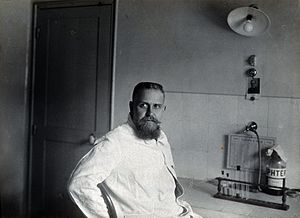Gaston Ramon facts for kids
Gaston Ramon (born September 30, 1886 – died June 8, 1963) was a smart French scientist. He was a veterinarian, which means he was a doctor for animals. He was also a biologist, someone who studies living things. Gaston Ramon is famous for his important work in treating serious diseases like diphtheria and tetanus.
Contents
Early Life
Gaston Ramon was born in a small town called Bellechaume in France. He went to a special school called l'École vétérinaire d'Alfort to become an animal doctor. Later, he got married in 1917.
Fighting Diseases
During the 1920s, Gaston Ramon and his colleague P. Descombey made huge steps forward in creating effective vaccines. Vaccines are like special training for your body's immune system. They help your body learn to fight off diseases before you get sick. Ramon's work focused on two very dangerous illnesses: diphtheria and tetanus.
Diphtheria and Tetanus
Diphtheria is a serious infection that can make it hard to breathe and swallow. Tetanus is another dangerous disease that causes painful muscle spasms. Both can be deadly. Before Ramon's work, these diseases were much more common and feared.
How He Made Vaccines Better
Gaston Ramon found a clever way to make vaccines safer and more effective. He used a chemical called formaldehyde to treat the toxins. Toxins are harmful poisons made by bacteria that cause diseases. By treating these toxins with formaldehyde, he made them harmless. But they still taught the body how to fight the real disease. This method is still used today to make many vaccines!
He also created a way to measure how strong a vaccine was. This was very important because it meant that every batch of vaccine made would work just as well. This helped doctors trust the vaccines and use them widely.
Recognition and Legacy
Gaston Ramon was nominated for the Nobel Prize 155 times! Even though he never won the prize, his work was incredibly important. It saved countless lives around the world by making effective vaccines against diphtheria and tetanus possible. His discoveries changed how we prevent these diseases forever.
His important papers and research notes are kept safe at the National Library of Medicine in the United States.
See also
 In Spanish: Gaston Ramon para niños
In Spanish: Gaston Ramon para niños


